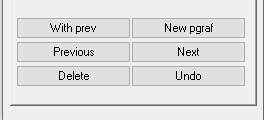Versions Compared
Key
- This line was added.
- This line was removed.
- Formatting was changed.

On this page
| Table of Contents |
|---|
The eXtyles Style Paragraphs function opens the Style Palette, which is a quicker and easier way to apply your template’s paragraph styles than applying formatting via Word’s menus or style list.
Each of your organization’s paragraph styles is represented on the eXtyles style palette, where it appears as a button. Additionally, from the eXtyles palette you can quickly traverse the document and confirm or change the style of each paragraph using the convenient “Undo,” “Next,” and “Previous” buttons.
| Info |
|---|
Each palette for eXtyles Custom users is configured differently for each organization. |
How to use
To style a document:
Open the style palette by selecting Style Paragraphs from the eXtyles menuto open the style palette.
Styles in the eXtyles style palette are divided into groups (tabs), which may be customized to suit your organization’s styles. For example, the tabs on a style palette might include the following:Front: covering front matter paragraphs
Body: covering paragraphs in the body of the document
List: covering list items
Object: covering boxes, tables, and figures
Back: covering back matter paragraphs
Style the document by selecting the desired tab on the palette and traversing the document, clicking the appropriate button to apply a style to the selected paragraph, or clicking “Next” to advance to the next paragraph without changing the style of the selected paragraph.
When you open the eXtyles style palette, the paragraph in which your cursor is located will become highlighted. After you click a style button to apply a style to that paragraph, the highlight advances automatically to the next paragraph. In this way you can quickly move through the document without clicking out of the palette.
| Info |
|---|
Tip! Use Hot Keys to apply styles and traverse your document quickly. |
| Tip |
|---|
Are you an eXtyles JATS user? Check out the eXtyles JATS Style Guide for a detailed description of how to use the styles available to you. |
| Tip |
|---|
Are you an eXtyles STS user? Check out the eXtyles STS Style Guide NISO 1.0 Export Filter for a detailed description of how to use the styles available to you. |
| Info |
|---|
Tip! Turn on Draft View in Word to see the applied paragraph styles in the margin. |
| Info |
|---|
Tip! Skip to next unique paragraph |
The buttons at the bottom of the Style Palette can be used to traverse the document during formatting.

Button | Function | Hotkey | ||
|---|---|---|---|---|
Next | Move to and select the next paragraph | X | ||
Previous | Move to and select the previous paragraph | V | ||
Delete | Remove the selected paragraph from the document and advance to the next paragraph | D | ||
Undo | Undo the last operation
| U | ||
With prev | Merge the selected paragraph with the previous one (the carriage return between them is replaced with a space). Use this function to merge an unwanted heading into the paragraph following it, for instance, or if two paragraphs are separate but should be one. | W | ||
New pgraf | Insert a return after the first sentence of the paragraph, creating two paragraphs from one.
| G |
Style Palette Tips
| Info |
|---|
All of these tips work when the Style Palette is open. |
→ Use the Tab and Shift + Tab keys on the keyboard to switch between the different style tabs on the palette.
→ Esc will close the palette.
→ The Shift key will change the behavior of certain functions.
Examples:
1. Shift+”Next” button or Shift+X skips all paragraphs styled with the current paragraph’s style, stopping at the next different paragraph style.
2. Hold Shift while clicking the table body style for your configuration to apply the table body style to the entirety of the table.
→ The style palette closes automatically after the document is completely styled.
→ You can reopen the palette at any time, and styling will continue with the paragraph where the cursor is currently located.
| Info |
|---|
Bonus Tip! After you style a document, you can easily navigate through it by jumping from heading to heading using Word’s Document Map feature. To use Word’s Document Map feature, check the box in View > Navigation Pane. |
| Info |
|---|
Find more information and tips for styling tables. |
| Info |
|---|
If you need to close the palette in the middle of processing, click the X box in the upper-right corner, or press Esc. |
Style palette alternatives
You can also use the Word paragraph style menu as usual if you are applying a paragraph style to just a few paragraphs.
If you use this method, please keep the following in mind:
The name on the button on the eXtyles Paragraph Style palette is not necessarily the same as the name of the Word paragraph style. Be sure to use the correct Word paragraph style.
Word has a bug (Microsoft calls it a “feature”) in which italic or bold markup or Symbol font changes in the middle of a paragraph may be lost when styles are applied from the Word Paragraph Style menu or ribbon. This problem is especially nasty in genetics papers, in which a gene may inadvertently be turned into a protein as a result. If you use this method of styling, be sure to proof the paragraph carefully. Using the eXtyles style palette avoids this bug in Word.


